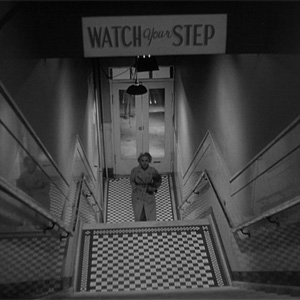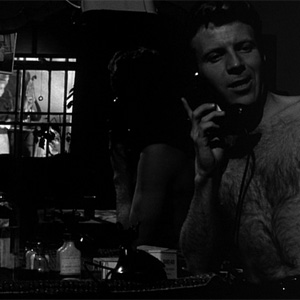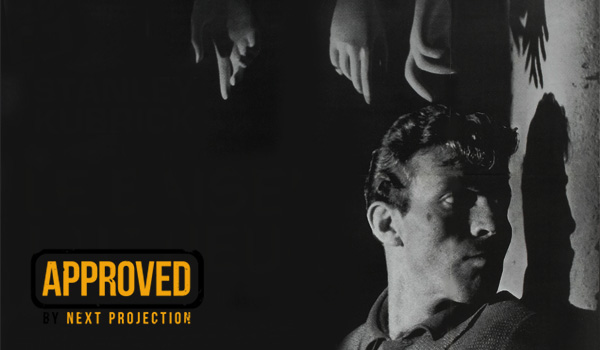Review: Killer’s Kiss (1955)
Cast: Frank Silvera, Jamie Smith
Director: Stanley Kubrick
Country: USA
Genre: Crime | Drama | Film-Noir | Thriller
Official Trailer: Here
Part of Matthew’s ongoing Kubrick retrospective. See the rest of the entries Here.
When the budding auteur does a genre film, it is not done with the same earnestness it would be had it been directed by a B-movie director. The auteur filters the most important elements of the genre film to condense it in to a self-aware entity that is quite different than a typical B-movie. When art meets pulp, that’s when the magic happens. It becomes self-referential and post-modern, becoming more of an artfully crafted homage piece than an earnest genre thriller. Such is the case with Stanley Kubrick’s Killer’s Kiss. Kubrick had already established himself as a master of the lens through his career as a photographer before moving on to film, and this mastery is evident in Killer’s Kiss as it transcends its genre roots to create something vibrant, original, fluid, and masterfully shot.
Kubrick also shows us his sense of humor as he secretly warns the participants in this dark tale with a sign that says “Watch Your Step” that looms over the characters’ heads. Such warnings are useless in a film-noir, as if they were to watch their step we wouldn’t have anything to watch.
 A genre film in the hands of an auteur becomes a carefully considered and masterfully crafted exercise in form and style. Narrative is secondary to the real power that lies in the imagery of the film. The “style versus substance” debate when it comes to film is a curious one. As film is a visual art, it is allowed to be an exercise in aesthetics and tone. It need not follow strict rules of conventional storytelling, nor need it bring something original to the table in terms of narrative content. Killer’s Kiss is not original or groundbreaking in its standard noir pulp story. We’ve seen the down and out boxer, femme fatale, bad guys and their secret plans stories before, but this time it is given new vibrancy through Kubrick’s mastery of style and form. Kubrick employs full frame compositions that breathe with life, and are rich with the artifacts of a bygone era of bad coffee and lousy diner food. Words are secondary to creating a living and breathing world and some of the most important parts of the film are merely background elements that assist in the creation of tone. In its short 67 minute runtime, Kubrick manages to deliver what needs to be delivered while stopping to consider the reflections on metallic surfaces or the way a fish bowl can distort our protagonist’s face and show the innocent nature that lay beneath the hardened punch-drunk surface.
A genre film in the hands of an auteur becomes a carefully considered and masterfully crafted exercise in form and style. Narrative is secondary to the real power that lies in the imagery of the film. The “style versus substance” debate when it comes to film is a curious one. As film is a visual art, it is allowed to be an exercise in aesthetics and tone. It need not follow strict rules of conventional storytelling, nor need it bring something original to the table in terms of narrative content. Killer’s Kiss is not original or groundbreaking in its standard noir pulp story. We’ve seen the down and out boxer, femme fatale, bad guys and their secret plans stories before, but this time it is given new vibrancy through Kubrick’s mastery of style and form. Kubrick employs full frame compositions that breathe with life, and are rich with the artifacts of a bygone era of bad coffee and lousy diner food. Words are secondary to creating a living and breathing world and some of the most important parts of the film are merely background elements that assist in the creation of tone. In its short 67 minute runtime, Kubrick manages to deliver what needs to be delivered while stopping to consider the reflections on metallic surfaces or the way a fish bowl can distort our protagonist’s face and show the innocent nature that lay beneath the hardened punch-drunk surface.
Kubrick employs a rich myriad of cinematic techniques to fill out the edges of this dark world. Slow and meticulous tracking shots and dense framing pay homage to Max Opuls one minute, only to give way to handheld cinema verite shots that concentrate on the emotional weight of the characters in the very next scene. Locker room shots before a fight get in close with our protagonist, simultaneously showing his pre-fight anxiety and granting us a behind the scenes view of places we would otherwise not be able to see. That is the power of cinema, it preserves time and space to allow us to see realities that are long dead so that we may satisfy our boundless curiosity and voyeuristic tendencies while documenting environments that will one day vanish.
Our boxer protagonist watches his neighbor undressing, but we are allowed to see what he sees from the mirror over his shoulder. We see what he sees through multiple layers of perverse joy and Kubrick’s self-reflexive commentary. We are coconspirators in his voyeurism as he cannot help but stare at what knows he shouldn’t be watching, but we join him in his transgressions through reflections as we steal visages from his environment.
 Kubrick is playful with his use of shadows, framing, and environmental objects to create visual humor and to add layers to the sparse and trope-filled narrative. Our boxer protagonist watches his neighbor undressing, but we are allowed to see what he sees from the mirror over his shoulder. We see what he sees through multiple layers of perverse joy and Kubrick’s self-reflexive commentary. We are coconspirators in his voyeurism as he cannot help but stare at what knows he shouldn’t be watching, but we join him in his transgressions through reflections as we steal visages from his environment. It is a succinct exercise in cinematic language that illustrates our true nature and makes us complacent in the questionable morality of someone who watches his neighbor as she gets undressed. We later find out that she is also in on this charade and she, like all of us, is complacent in a world of broken morality. Kubrick also shows us his sense of humor as he secretly warns the participants in this dark tale with a sign that says “Watch Your Step” that looms over the characters’ heads. Such warnings are useless in a film-noir, as if they were to watch their step we wouldn’t have anything to watch. These clever insertions aren’t extraneous to the plot; they are essentially the stuff that make up the most important parts of the film. They are not essential components to the unfolding of the narrative, but they sit at the center of the frame as rewards for those attentive enough to notice their presence.
Kubrick is playful with his use of shadows, framing, and environmental objects to create visual humor and to add layers to the sparse and trope-filled narrative. Our boxer protagonist watches his neighbor undressing, but we are allowed to see what he sees from the mirror over his shoulder. We see what he sees through multiple layers of perverse joy and Kubrick’s self-reflexive commentary. We are coconspirators in his voyeurism as he cannot help but stare at what knows he shouldn’t be watching, but we join him in his transgressions through reflections as we steal visages from his environment. It is a succinct exercise in cinematic language that illustrates our true nature and makes us complacent in the questionable morality of someone who watches his neighbor as she gets undressed. We later find out that she is also in on this charade and she, like all of us, is complacent in a world of broken morality. Kubrick also shows us his sense of humor as he secretly warns the participants in this dark tale with a sign that says “Watch Your Step” that looms over the characters’ heads. Such warnings are useless in a film-noir, as if they were to watch their step we wouldn’t have anything to watch. These clever insertions aren’t extraneous to the plot; they are essentially the stuff that make up the most important parts of the film. They are not essential components to the unfolding of the narrative, but they sit at the center of the frame as rewards for those attentive enough to notice their presence.
Kubrick financed this film with the money of his friends and family, and shot and edited it himself with little in the way of financial or technical resources. It shows what a budding master can do with little more than the world that surrounds him, a camera to point at it, and a few characters to fill in the rest and tell the seedy tale. He shows the cracks on the streets, the shadows as they cast bars across the walls warning our prisoners of the dangers of their reckless nighttime lifestyles, neon lights as they show us the advertisements and preoccupations of citizens in a bygone era, and the grandiosity of lonely urban nights as beastly metallic automobiles bounce the neon of the streets to create a sense of the untouchable and pristine in the wild and untamed darkness of city nights. Killer’s Kiss is a labor of love that pays homage to B cinema and serves as an example of how an artist creates because he must, and not because he can afford to.
-
http://madman731.blogspot.com/ Andrew Madsen
-
http://www.facebook.com/blevo Matthew Blevins














 Review: Prometheus (2012)
Review: Prometheus (2012) Subversive Saturday: The Red and the White (1967)
Subversive Saturday: The Red and the White (1967) Review: Oslo, August 31st (2011)
Review: Oslo, August 31st (2011) Review: Piranha 3DD (2012)
Review: Piranha 3DD (2012) Review: Snow White and the Huntsman (2012)
Review: Snow White and the Huntsman (2012)

